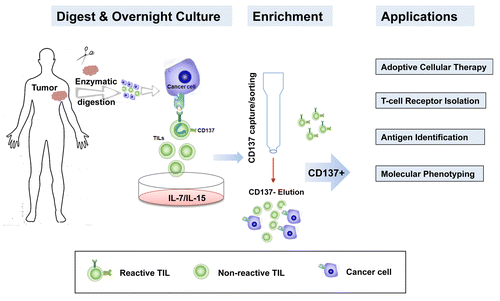Figures & data
Figure 1. Isolation of CD137+ T cells from clinical tumor specimens. CD137 is selectively expressed on tumor-infiltrating lymphocytes (TILs) that have been activated upon encounter with tumor-associated antigens (TAAs). Upon the enzymatic dissociation of tumor samples, the expression of CD137 among TILs can be increased by overnight exposure to interleukin (IL)-7 and IL-15. Strategies that allow for the enrichment of CD137+ TILs represents the next step toward the improvement of adoptive CD137+ T-cell transfer and downstream translational investigations, including the sequencing of T-cell receptor (TCR)-coding genes, the identification of novel TAAs and the molecular phenotyping of specific TIL subsets.
